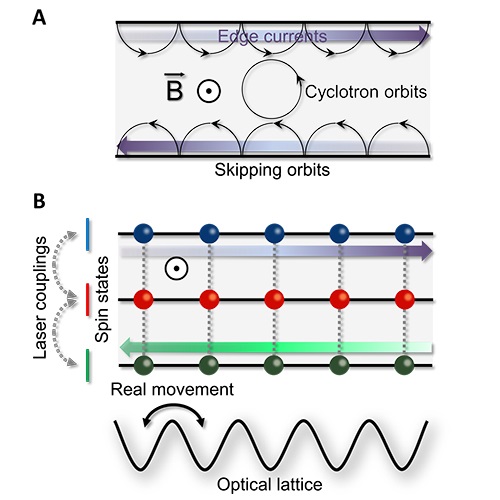2015/09/25
Imagine a particle immersed in a strong magnetic field. Classically, it will accelerate perpendicularly to its velocity and describe a circular cyclotron orbit. Quantum mechanically, the same will happen but the energy of the orbit will be quantized. This situation appears naturally for electrons in a two-dimensional material subjected to a strong magnetic field, which is insulating because the electrons are confined in cyclotron orbits. Close to the edge of the sample the situation is different, since the electrons will not have enough space to complete their orbits and will keep bouncing off the edge and starting new ones. The skipping of orbits leads to persistent edge currents with a direction imposed by the magnetic field. These currents are quantized too and protected against small perturbations by the topology of the energy bands. They are therefore a hallmark of topological systems.
Although predicted in the ’80s, edge states are very difficult to observe in condensed matter systems because visualizing the electron trajectories is extremely challenging. Last year, an ICFO-driven theoretical collaboration pushed forward by Dr. Alessio Celi and Dr. Pietro Massignan, led by ICREA Professor at ICFO Dr. Maciej Lewenstein, proposed an original scheme for simulating efficiently this physics using instead cold atoms trapped in an optical lattice and subjected to a synthetic dimension and a synthetic magnetic field.
In the recent Perspective article entitled “Probing the edge with cold atoms”, ICFO research fellow Dr. Alessio Celi and ICFO Professor Dr. Leticia Tarruell give their view on two recent experiments which have successfully implemented this approach in the laboratory, and discuss the exciting perspectives opened up by these ideas. The experimental studies, which visualize in a striking manner the skipping orbits associated to the edge currents, have been performed by Prof. I.B. Spielman’s research group at NIST (USA) and Prof. L. Fallani’s research group at LENS (Italy), and appear together with the Perspective article in the current issue of Science.
Link to the paper
Link to research group led by ICREA Professor at ICFO Dr. Maciej Lewenstein
Link to research group led by ICFO Professor Dr. Leticia Tarruell

Exploring edges with synthetic dimensions
ICFO research fellow A.Celi and ICFO Professor L.Tarruell comment in Science on the experimental visualization of edge currents using cold atoms trapped in synthetic lattices.

Exploring edges with synthetic dimensions











